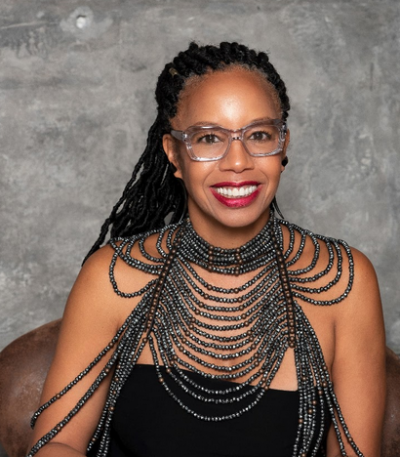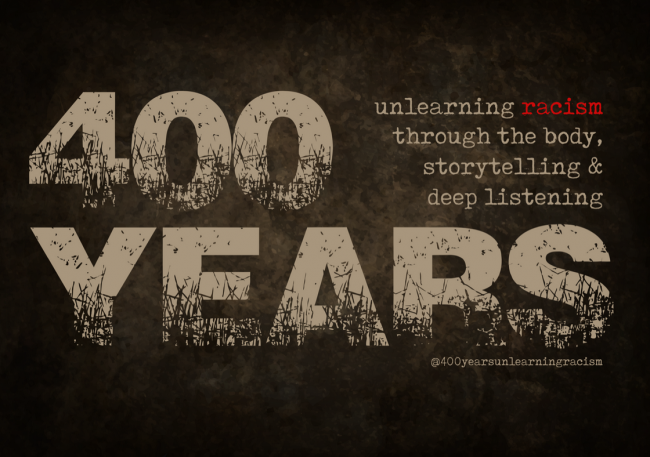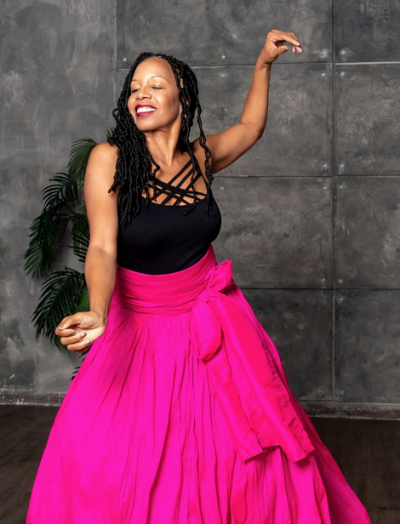400 Years: Beyond Anti-Racism - the Embodiment of Ancestral Healing
By Bernadette Pleasant
 How the hell did we get here? The day George Floyd was murdered made me think of Nina Simone’s 1963 song, “Mississippi Goddam.” Eight minutes and 46 seconds! Police Officer Derek Chauvin, dressed in blue, wearing a badge, tasked with the responsibility of serving and protecting, casually put his knee and the entire weight of his body on the neck of a Black man. He heard Floyd crying, begging, pleading, gasping for air, yet showed him no mercy. In eight minutes and 46 seconds, like a hunter standing atop his prey, Office Chauvin posed as a man’s lungs took their last breath, his heart stopped beating, his brain ceased functioning, and his body was rendered lifeless in broad daylight, with bystanders watching. America, goddam!
How the hell did we get here? The day George Floyd was murdered made me think of Nina Simone’s 1963 song, “Mississippi Goddam.” Eight minutes and 46 seconds! Police Officer Derek Chauvin, dressed in blue, wearing a badge, tasked with the responsibility of serving and protecting, casually put his knee and the entire weight of his body on the neck of a Black man. He heard Floyd crying, begging, pleading, gasping for air, yet showed him no mercy. In eight minutes and 46 seconds, like a hunter standing atop his prey, Office Chauvin posed as a man’s lungs took their last breath, his heart stopped beating, his brain ceased functioning, and his body was rendered lifeless in broad daylight, with bystanders watching. America, goddam!
People on the streets gasped from the shock of what they were witnessing. People at home gasped, held their breaths, watched their screens, waiting, hoping for a release. The world gasped, watching a nightmare unfold. In the midst of a global pandemic, Floyd’s words, “I can’t breathe!” took on a deep and multilayered meaning.
In the aftermath of this brutal murder, there was outrage, like an internal combustion in the bodies of all those who have a conscience. There was terror, for some, at seeing what they hoped to never witness again. History is filled with countless Black folks’ bodies, Black folks’ names, Black folks’ lives that were snuffed out at the hands of racial injustice.
But there was something different this time. There was something especially disturbing about the casualness of it all. How could something so unspeakable be done with such unconcern? How did we get here?
We did not get here overnight. We got here slowly. We got here by not listening, not paying attention, not caring, not thinking it mattered to us personally — until it did. This was about the tragedy of George Floyd’s murder and it was also about what Mr. Floyd embodied in that moment. As all eyes watched, glued to our screens because there was no place to go during a global pandemic; we witnessed a stark depiction of racial terror that was both individual and collective. There was nowhere to go, so everyone watched. But everyone didn’t watch through the same lens.
For Black people, there was a palpable feeling of anger, grief, anguish, fight, flight, revolt, and exhaustion. It brought up deep ancestral fear, the kind of fear that lives in the bodies of those who know that it was once commonplace to be lynched or beaten for even a perceived transgression. This moment turned back the hands of time, triggering trauma in Black bodies, the generational grief that is passed on from mother to child. It’s the fear that haunts Black families when their children step outside, away from protective gaze. Will my baby be okay? Will they be safe? Will their skin be seen as a bullseye? Will they be respected as a human being? Many of us wondered how much more we could bear after losing Ahmaud Arbery, Breonna Taylor, Philando Castile, Botham Jean, Trayvon Martin, Michael Brown, Eric Garner, Sandra Bland, Tamir Rice and countless others to heartless acts of brutality and injustice.
For those who do not inhabit Black bodies, this moment raised different questions. How could something like this happen? Were things really that bad for Black people? For many concerned White people, the response was shock, disbelief, disgust, and outrage.
It was as if a light had gone on and everyone was squinting under the excruciating pain of that eight minutes and 46 seconds of blinding, high voltage. Sadly, it took a worldwide pandemic and a racially charged political climate to pry open some sleeping eyes. But here we were. Everyone had seen what they could never unsee — and when we closed our eyes, there was nowhere to look but inside.
There was no turning back. Something had to be done, and this moment brought out people’s true mettle. People who lacked courage, found it. People who’d not spoken, discovered their voices. People who didn’t know what to do, sought out solutions and sincerely wanted to learn. People who were afraid to teach, realized that now, more than ever, they couldn’t afford not to be teachers.
The inner ancestors emerged for all of us. For White people, it was time to face the ancestral experience of racial ambivalence, the safety, neutrality, comfort, and privilege of not knowing or understanding the realities of racial injustice. There was no longer room for the illusion that race was merely a thing of the past or a naive belief that “we are all in this together.” There were no more excuses for turning a blind eye to the clear and present reality of rampant inhumanity.
For Black and Brown people, it was an embodied experience. I felt it in my own body and saw it in the bodies of others. It was like we’d been frozen on the outside from shock and fear. Then an internal inferno erupted, cracked through the ice of our exterior, and burst into flames — into an unstoppable momentum, a fiery commitment to ensure that this never happens again.
I think that all of our ancestors appeared internally to shapeshift this moment. I believe that healing happens both backwards and forward. What I know for certain is that my proud ancestors, who lost their right to speak up during their lifetimes, are alive now in me.
What I witnessed that day, that evening, that moment when I saw that horror, changed me forever. I could no longer sit in the place of the unspoken. I could no longer wait. This was a call to action from my ancestors who braved a painful past and for the next generation who will inherit the future. It was important for my daughter and grandchildren to see me take a stand.
Despite my own exhaustion, I was no longer willing to look away when White friends called after George Floyd’s murder wondering what they could do, what they could read, and where they could turn to get educated. While the responsibility of getting educated falls on the one seeking the education, I also knew that I was being called to be one of the educators.
Anti-racism programs and resources were quickly emerging everywhere. But for me, it wasn’t about simply giving White people a checklist of how to perform in ways that weren’t racist. What was needed was a process of unlearning racism.
What I observed is that when White friends contacted me to talk about race, they weren’t looking for superficial answers or a simple script to follow. In my decades working with body-centric somatic healing, I could hear the tightness in their voices, see the tension in their bodies, feel the grip of conflict, shame, guilt, and unresolved emotions. While their visceral feelings were different from those of African Americans, the blinding light of this traumatic tragedy had unearthed something for them that was also deep, ancestral, and intense. The resources available to them spoke to the facts of racism but didn’t address the body. The body speaks volumes. It never lies; and these bodies were scared.
As I spent some time alone, in the woods, in a quiet and sacred space wrestling with the weight of this entire experience, I got clear about my place in the work of racial and ancestral healing. For those who were committed to being conscious, who hungered to contribute to humanity, who were willing to venture outside of their comfort zones to learn, I could offer a safe space for them to do the deep work. In order to make meaningful change, we all have to be able to hear. For that to happen, we need to feel safe and able to relax the body to allow new information to come in. A shame-free zone is needed where questions, mistakes, and uncertainty are all welcomed without fear of not knowing or getting it wrong.
This work is like having a meal. Honoring a process of unlearning a centuries-old reality of racism can’t be treated like grabbing fast food on the run. When a table is set and a healthy meal is prepared and served well while sitting together at a table, it has a way of calming the nervous system and leading to proper digestion.

My ancestors were calling me to set that table and serve that meal. So, I created a program called 400 Years: Unlearning Racism Through the Body, Storytelling & Deep Listening. My ancestors had learned to communicate just by looking at each other; by gesturing, by symbolism. It was an unspoken communication, private and silent because it had to be. They had to be silent; but now I was being called to be silent no more.
I had to open my mouth and tell people who didn’t look like me what these unspoken conversations meant. I had to be unapologetically honest about what they did not know. In return, they had to be prepared to listen and learn — not to save us; but to save themselves and to set all of us free from the ancestral bondages of racism.
In 400 Years, we take racism out of the history books, out of antidotes and ideologies. We tell real, raw, truthful, painful first-person accounts of our stories and we tell those honestly. We get vulnerable in front of people who do not look like us. We give our ancestors the voice that they were once denied, and we allow those who have not experienced life in Black bodies to understand what happens inside our souls and our skins.
400 Years welcomes everyone who wants to show up and heal. We welcome all parts of you — your hair, your skin, your questions, your fears. Every part of you is safe here, as we sit around this sacred table. I realize that some things will be easier to digest than others. I am keenly aware that some will feel fearful and tight as we approach uncomfortable conversations. It is actually my hope that no one ever feels comfortable about racism again. So, I welcome that discomfort, without any shame. My desire is to move our bodies through all of it and not pull a rug over any of the parts that are difficult.
This is the time and place to bring that discomfort to the table, to be seen and heard, to share, talk, listen, and learn. When we embody truth, we get to heal ourselves and break the chains that exist along our ancestral lines. Embodied truth heals us. It enlightens us. It teaches us how to co-exist and shows us a new way of being so we can create a path forward together.
 Intoxicating and energetic, Bernadette Pleasant is a fiery and sensual speaker, somatic healer, and creator of The Emotional Institute LLC... 400 Years: Unlearning Racism... and Femme!, a mind-body wellness program. She has spent a lifetime exploring creative visualizations and celebrations of the human form, from sensual dance to somatic healing. A gifted healer, dancer, and entrepreneur, she channels her personal journeys and her radical empathy into transformative, immersive experiences that empower and celebrate people of all genders, ages, sizes, and fitness levels. Bernadette travels globally empowering all through classes, private workshops, retreats, and conferences.
Intoxicating and energetic, Bernadette Pleasant is a fiery and sensual speaker, somatic healer, and creator of The Emotional Institute LLC... 400 Years: Unlearning Racism... and Femme!, a mind-body wellness program. She has spent a lifetime exploring creative visualizations and celebrations of the human form, from sensual dance to somatic healing. A gifted healer, dancer, and entrepreneur, she channels her personal journeys and her radical empathy into transformative, immersive experiences that empower and celebrate people of all genders, ages, sizes, and fitness levels. Bernadette travels globally empowering all through classes, private workshops, retreats, and conferences.
With certifications in Emotions-Centered Coaching, Nia Technique, Nia 5 Stages, Ageless Grace, Pole Dance, Somatic Healing, Reiki, and Integrated Energy Therapy — and studies in African, Tribal, and Free Dance — Bernadette promotes emotional freedom through movement and empowerment.
Bernadette regularly leads discussions on emotional healing, grief rituals, inclusive movement, and empowerment for all. Her authenticity, charisma, and warmth allow her to empathize with and inspire those ready for a journey of emotional exploration and affirmation. Intuitive and engaging, Bernadette is a vibrant, sensual speaker who connects with those who have been silenced and shut down to support their physical, emotional, and healing journeys — whether in a classroom, from a podium, or one-on-one.
Bernadette, a woman of color, comes from a long line of natural healers who have used touch and movement to help others find peace, empowerment, and wellness. Her classrooms welcome participants without judgment, and support their paths to finding comfort in their own skin. In the Femme! experience, Bernadette creates a safe space for all ages, backgrounds, body types, and dance skills to explore their sensual selves. Everyone is empowered to fully embrace and embody all of their emotions and fully express them through movement; joy, sorrow, rage, ecstasy, and more are all welcome at Femme! In Femme! everyone is infused with the affirmation, “It’s your body; you can do whatever you want with it — including love it unapologetically!”
Catalyst is produced by The Shift Network to feature inspiring stories and provide information to help shift consciousness and take practical action. To receive Catalyst twice a month, sign up here.
This article appears in: 2021 Catalyst, Issue 3: Ancestral Healing Summit & Black History Month



